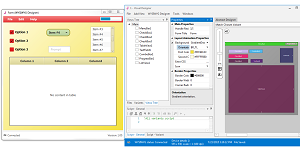Free Tool Offered as Classic Visual Basic Successor
Classic Visual Basic refuses to die. There's just something about Dims and Subs that programmers won't let go of.
The granddaddy of rapid application development (RAD) tools -- known for its simplicity and drag-and-drop ease of use -- was created by Microsoft 24 years ago and has enjoyed a voluble cult following despite losing official mainstream support in 2005.
Now comes from an Israeli company a free tool called B4J that "takes up where Visual Basic left off."
Anywhere Software yesterday announced the tool has been added to its B4X RAD suite, joining similar offerings such as B4A (formerly called Basic4andorid) and B4i (for developing iOS apps on Windows). This latest addition to the stable targets desktop and server applications running on Windows, Mac, Linux and ARM platforms such as Raspberry Pi.
 [Click on image for larger view.]
The Visual Designer in B4J (source: Anywhere Software)
[Click on image for larger view.]
The Visual Designer in B4J (source: Anywhere Software)
The Yodfat, Israel-based company said the free tool was created to meet "vocal market demand for a modern alternative to Visual Basic 6."
That edition of VB, released in 1998, is probably the most popular variant out of many. It was supplanted by Visual Basic .NET for the Microsoft .NET Framework in 2002, but that version wasn't backwards-compatible and never enjoyed the same vocal popularity as VB6. While VB.NET continues to evolve, it's just not the same. In fact, recent programming popularity indices reported it has fallen off in developer mindshare.
Throughout the years, however, many derivatives of VB have been created, and variations such as Visual Basic for Applications (VBA) still thrive, as any builder of Microsoft Office macros knows full well (or Active Server Pages developers, who use VBScript).
Popular support of the venerable language was demonstrated by a petition drafted by Microsoft MVPs requesting that Microsoft alter its strategy to keep the classic version going in 2005.
"We would like to suggest a path for the future development of Visual Basic 6 (VB6) and VBA that helps Microsoft align its long-term strategies with those of its customers," the petition signed by more than 14,000 developers states. "This path will also help Microsoft reconnect with the Visual Basic developer community and continue support for the Office developer community."
That petition didn't alter Microsoft's strategy much, but Anywhere Software CEO is hoping his new tool will help meet the demand for classic VB.
"There is a very large community of developers that grew up on VB6 and are still looking for a worthy substitute," Uziel said in a statement yesterday. "Their voice is loud and clear -- they want a modern RAD tool that will let them build real-world desktop and server apps without the hassles and complexity of existing programming languages. B4J provides an easy-to-use environment that lets developers get the job done."
Anywhere Software said B4J comes with a full-featured IDE including a visual designer, debugger, compiler and packager used to develop self-contained installers without any dependencies, along with "hundreds of libraries."
"Similar to VB6, B4J is a simple and powerful cross-platform tool designed to take the learning curve out of desktop app development," the company said.
That simplicity stems from the original philosophy of the BASIC (Beginner's All-purpose Symbolic Instruction Code) language, designed by Thomas E. Kurtz and John G. Kemeny in 1964, according to Wikipedia.
"Once upon a time, knowing how to use a computer was virtually synonymous with knowing how to program one," Time wrote last year in a 50-year celebration of the Visual Basic progenitor. "And the thing that made it possible was a programming language called BASIC."
Many now-aging cub developers (including this one) cut their programming teeth on BASIC-derived languages and tooling, such as GW-BASIC that shipped with 5-1/4-inch floppy disks for the MS-DOS operating system, and the subsequent QuickBasic and QBasic offerings.
Anywhere Software's Uziel hopes to keep the ball rolling.
"B4J is being used by our growing developer community to roll out real-world apps that solve everyday business problems faster than ever before," he said. "Based on the feedback we've received, B4J is being welcomed as an effective and long-awaited successor to Visual Basic."
Will you be welcoming BJ4 as a successor to VB? What exactly is the appeal of the classic RAD language? Share your comments here or drop me a line.
Posted by David Ramel on August 18, 2015